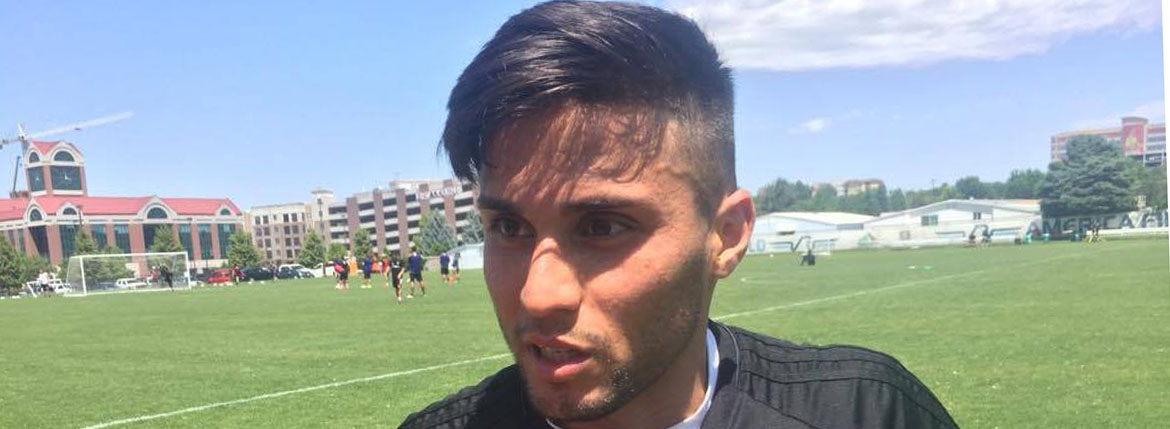
Jose Hernandez followed his graduation from the Grande Sports Academy with a year of college soccer at UCLA. He is currently in his rookie season with Real Salt Lake in Salt Lake City. (Photo by Eric Newman/Cronkite News)
PHOENIX – As Major League Soccer made developing local talent for its teams a priority in recent years, the Grande Sports Academy was an early player in the trend of the sport’s elite moving away from U.S. club and high school programs in favor of attending academies.
Grande, a full-time, year-round residency in Casa Grande that opened in 2010, is the first of its kind in MLS and the only one in Arizona. Until recently, it partnered with Real Salt Lake of Salt Lake City as a funnel for players into the professional ranks. Grande’s athletes live on site in dormitories, with access to performance and nutritional facilities as well as a branch of ASU Preparatory Academy for classes on campus.
“I think, especially with how soccer is growing in the country, the academy has taken over the past six or seven years now. Club soccer is pretty much dying out,” said Jose Hernandez, a Grande graduate who played collegiately at UCLA before signing with Real Salt Lake this season. “(Academies are) where all the big schools are looking to recruit from now. They don’t really look at high school soccer as much as they used to.”
Because of the academies, playing on some of the best competitive clubs or high school teams puts players at a disadvantage in trying to play their way onto bigger stages, Hernandez said.
Many of the academies are a reaction to the MLS Youth Development Initiative, which encouraged teams to establish youth programs that would help cultivate the best local talent. This reflects the trend of the world’s best leagues, where top players are identified early and receive professional coaching as teens.
When the initiative began, MLS teams were able to cultivate solid talent. However, without living quarters, the clubs were limited to players who were able to commute daily to training. Offering a residence allowed Grande to recruit players from farther away, providing a larger talent pool.
Now, like the other elite soccer-playing nations in the world, full-time academies are the top stage for athletes to play their way onto college and professional teams in the United States.
Grande general manager Tim Alai said that every student who has graduated from the Grande Sports Academy has either received a college athletic scholarship or has signed a contract with a professional team. That translates to 131 college scholarships and 33 professional contracts to date, according to an academy press release.
Grande is now partnered with one of the top soccer teams in the world, FC Barcelona, making it the only U.S. academy paired with one of Europe’s top teams.
Since teaming with the Spanish club on June 7, Alai said Grande has received more than 3,300 online applications and thousands more informal phone calls for information and tours. Typically holding a class of 60-80 people each year, he speculated that available talent could bump that average to 180 players in the coming years.
Not only is Grande associated with a team in contention for Spanish and International titles each year, but one that is renowned for its talent evaluation and youth development, specifically that of Lionel Messi, the Argentine forward who has scored more than 400 goals for club and country.
Short of going to La Masia, Barcelona’s local youth academy in Spain, Alai said the academy in Casa Grande now presents the best opportunity for young players in the country to improve.
“This is a dream for many of these young guys. Unless you’re invited in, they’re not getting to play over there,” he said.
Brooks Lennon, 19, from Paradise Valley, was one of the many players to sign a professional contract after graduation from Grande, signing with English power Liverpool FC. He is currently on loan to Real Salt Lake.
Lennon plays a significant role for RSL, often starting as a forward for a team in MLS playoff contention at such a young age. He even started for the United States in the U-20 World Cup in South Korea this summer.
Both Lennon and Hernandez are part of a large contingent of players who are now on Real Salt Lake’s first team. Designated as “homegrown” players, eight on RSL’s roster spent time at Grande.
Lennon said his technical ability was honed at Grande, and he benefited from the experience of playing on as big a stage as possible for his age group.
“I wanted to be playing with the best of my age, and be coached by the best coaches possible, so I made a decision to go to Casa Grande,” he said.
“And I’m benefiting from it now.”